Pressure bulkhead, not mirror.As I have stated elsewhere, the reason why I keep mentioning "Hexagon forward section" is that I worked on the Hexagon program for four years, and I am confident that I know one when I see one.
And I don't know why you keep mentioning "Hexagon forward section." This is not Hexagon.
Dr. Day states that what I theorize is a mirror in the drawing in his 23 June 2014 Space Review article is a pressure bulkhead rather than a mirror. This is implausible for several reasons. The ends of pressure vessels tend to be hemispherical, the most efficient shape. There is no shadowing of the object that Dr. Day says is a pressure bulkhead, so it does not look like a concave object at all, it looks like a shiny disc. And, there is a noticeable thickness to the disc, as one would expect of a glass mirror. Also, what Dr. Day says is a pressure bulkhead is only about five feet in diameter. From an engineer's point of view, this makes no sense; a hemispherical pressure bulkhead at the end of a ten-foot diameter tube ought to be ten feet in diameter.
Obviously, one of us is wrong. I don't really care, because in the end what is important is that someone gets it right. Debating the evidence is healthy; it is how we triangulate on truth, unless the debate degenerates into "I don't know what you're seeing" and "you're mistaken," since that merely a polite veneer for shouting "You're wrong!" "No, you're wrong!" There is no profit in that. To construct a widely acceptable theory, one most account for all the evidence in a plausible and logically consistent manner.
So, let's examine the evidence, largely evidence that Dr. Day himself has introduced.
Exhibit A (Hexagon):
This image appeared in Dr. Day's 7 February 2011 Space Review article. Anyone can verify that the scale of the Exhibit A is 135 pixels per five meters, and that the Hexagon forward section is 185 pixels long, which converts to 6.85 meters, or 20.76 feet.
Exhibit B (Dorian):
This image appeared in Dr. Day's 23 June 2014 Space Review article:. I rotated the image 33 degrees right so that the spacecraft is horizontal. The scale of the drawing is 333 pixels per 36 feet; what I theorize is the Hexagon forward section is 192 pixels long, which converts to 20.76 feet, the same length as calculated for Hexagon forward section in Exhibit A.
I believe in coincidences. Coincidences happen every day. But I don't trust them.
Exhibit C (Dorian):
This image appeared in Dr. Day's 16 July 2012 Space Review article. It depicts the KH-10 primary mirror at the aft end of the MOL spacecraft, essentially the same diameter and in the same position as the shiny disc in Exhibit B that Dr. Day now claims is a pressure bulkhead. Thus it would seem that Dr. Day is contradicting the art that appears in his own article.
Also note that the drawing depicts light baffles mounted on the interior of the 10-foot diameter body of the spacecraft, whereas the commentator identifying himself as "Byeman" claims that the structure depicted in Exhibit B, improbably suspended from the mid section of the spacecraft like some ponderous chandelier with no apparent lateral support, is a light baffle structure. The two drawings bear no resemblance to each other in this regard.
Exhibit D (Hexagon):
This image appeared in Dr. Day's 31 October 2011 Space Review article.
Exhibit E (Dorian and Hexagon):
Since Exhibit B is somewhat larger scale, I resized the rotated image as required to be consistent with the scale of Exhibit D, whited out the parts the images that show anything other than what I understand to depict the Hexagon forward section and the camera section, and outlined the remaining structure in red. I rotated the Exhibit D image 150 degrees left so that the spacecraft is horizontal; I also whited out the mapping camera, film supply section, and aft section. Exhibit E is a side-by-side comparison of the resultant images. The perspective is different, one isometric looking forward, the other isometric looking aft, but it appears to be the same structure.
I will say again that I could be wrong; after all, image quality of Exhibit B and Exhibit G leaves much to be desired. However, if I am wrong, it is with good reason. I would revise my theory in the face of better evidence.
Dr. Day states in his 23 June 2014 Space Review article:
Over the past decade, information on MOL has come out from various sources. In 2004, an Aerospace Corporation article appearing in their in-house magazine indicated that MOL had also been designed to operate without a crew. In 2012, the NRO released a 1965 drawing that showed a preliminary concept of this “Unmanned MOL.” Now a more detailed drawing of the “Baseline MOL Unmanned Mode” has been released, showing far more detail, including what appears to be up to twelve satellite recovery vehicles (SRVs) used to return film to Earth.One question I have for Dr. Day regarding Exhibit B is how he counts 12 SRVs in the unmanned configuration. I see only six. There are a couple of objects in the nose of the fairing ahead of the SRVs, but they look different from the two rows of three uniform objects each. Where are the other buckets?
"Various sources" can get things wrong; things may be misconstrued and taken in the wrong context. I do not know for certain what image Dr. Day refers to as having been released in 2012, but perhaps it is Exhibit F:
As I have theorized elsewhere, Exhibit F is probably close in context, i.e. time, to Exhibit G:
Most important is to note that neither Exhibit B, Exhibit F, nor Exhibit G has a date on it, so one is left to speculate. I would point out that neither Exhibit E or Exhibit G bears the Dorian classification marking. From this fact, taken together with the simple nature of the drawings, my impression is that these are very early drawings from the MOL program; indeed they may well date from the time that it was still a study called MODS. My understanding of these two images is that the early concept of MODS or MOL was that it was to be launched unmanned, and then visited by manned resupply vehicles. An imperfect but useful analogy would be the usually unmanned but occasionally man-tended Hubble telescope.
In contrast to Exhibit F and Exhibit G, Exhibit B bears the (D) security marking that may well stand for Dorian, and it is also a drawing that is much richer in detail, the detail of which would apparently be richer still were the reproduction of the required quality. These two facts taken together suggest that this is a much later drawing from when the MOL design was well defined, near the time of Preliminary Design Review or later. Thus, I do not believe that there is any connection between Exhibit F and Exhibit B other than the fact that they both depict two rows of three SRVs each.
I believe that Exhibit B represents a last ditch effort of the MOL program office to save the program from cancellation by taking the man out of the loop to reduce cost and increase film return capability, and that an expedient was to fall back on the six-bucket configuration of the early man-tended concept. This in itself was insufficient to save the program; not only was the cost of man in the loop a concern, and not only was the cost of developing the seven-segment Titan IIIM a concern (in 1981 a major who had worked on Titan IIIM expressed doubt that it could have launched on schedule), but the very resolution capability of KH-10 was seriously in question in the intelligence community: "Why four inches?" The more important question was not, is it worth the cost, but do we need this at all. This I believe explains the Hexagon kludge onto MOL. Exhibit B depicts the KH-9 camera system, whose capability had broad support within the intelligence community, being substituted for KH-10, the value of which many questioned, in the hope that the two program offices would be merged, and that the effort that had gone into Titan IIIM would be redeemed. I believe that Exhibit B is not really Dorian at all, but a clumsy attempt to promote a Super Hexagon, the expense of launching on Titan IIIM being justified by sporting ten buckets (the primitive Dorian concept's six plus the mature Hexagon's four). Similarly, Exhibit H, a drawing contemporaneous to Exhibit B, which appeared in Dr. Day's 23 June 2014 Space Review article, depicts the option of retaining man in the loop:
The program office hoped for approval of one of these choices, either Exhibit B or Exhibit H, not both, to save the MOL program from termination.
The bottom line is that I do not believe that any of the Dorian drawings that the National Reconnaissance Office has released to date resemble any engineering drawings that were used to bend metal. I think that what we have been fed are briefing charts to senior management of concepts that were considerably removed from reality. Every program generates this sort of wishful thinking; one need only look to the many imagined evolutions of Gemini, the Apollo LM, and the Space Shuttle. The true Dorian, by which I mean the design that was actually being worked to at the time of program termination in June 1969, has yet to be revealed. Meanwhile, the NRO has researchers chasing their tails.
Responses to Anonymous Comments on Hexagon-Dorian
Ode to Big Bird, Part 9: STS-4 and STS-39

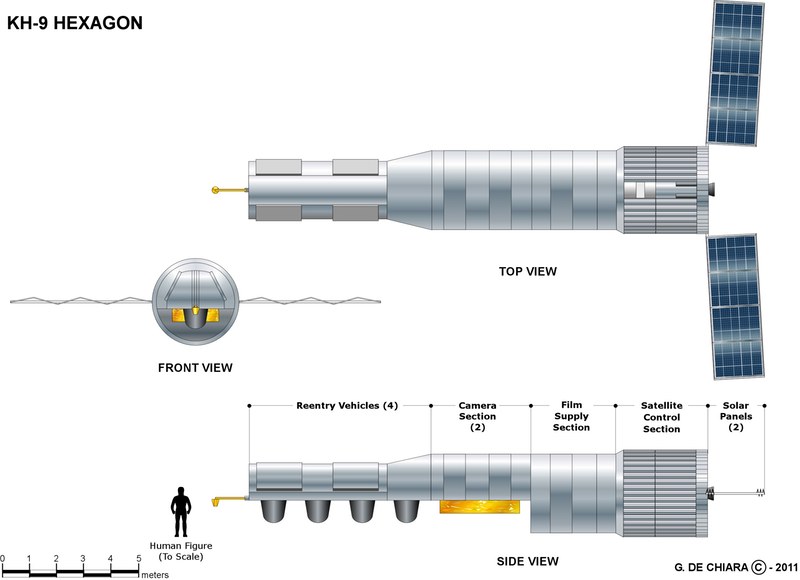
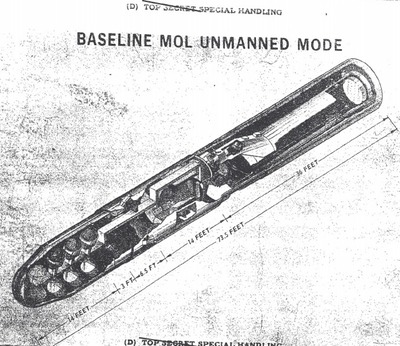
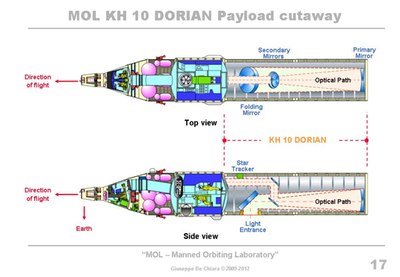
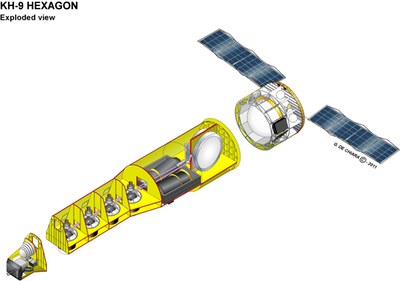



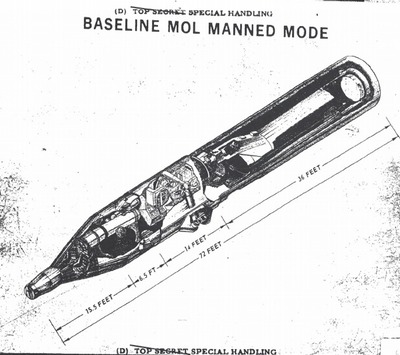





5 comments:
You need to get off this Hexagon forward section kick. It is not buried in the aft of Dorian. you are seeing things that are not there. There is no purpose for it to be there and it would obstruct the light path.
As for Day's comment about the pressure bulkhead, he doesn't mean the mirror on the aft of Dorian, which he knows is a mirror. Day is referring to the bulkhead on the manned portion of the station. When you said "Hexagon Forward Section" both him and I think you are referring to the forward part of Dorian. Because unlike you, we don't see a "Hexagon Forward Section" buried in the aft portion of Dorian, because:
a. It doesn't look like it
b. It makes no sense.
Look here:
http://commons.wikimedia.org/wiki/Category:KH-10_DORIAN#mediaviewer/File:Dorian_2.jpg
This shows that it is not a "Hexagon Forward Section"
I need to get off this kick? How rude and unprofessional. Why should I abandon my analysis on the mere say-so of an anonymous heckler? And how is it that he presumes to speak for Dr. Day? Since he has admitted to being confused about certain aspects of my analysis, I would suggest that his best course of action would be to study it with greater care rather than fire off half-cocked. If we keep the conversation respectful, focus on the available evidence, and assemble lines of logical reasoning. we may learn together.
Stating that a "Hexagon forward section" is buried in the aft section of the Dorian is a " half-cocked" analysis. Why would a structure whose sole purpose is to support SRV's be buried in the light path of the optics of reconsat and that doesn't have an opening for the SRV's to leave the vehicle.
Your first sentence is a continuation of your earlier rudeness. I will answer none of your questions while you persist in being abusing and disparaging.
Meanwhile, my observations regarding Dorian and Hexagon have resulted in striking up a friendship with a fellow Air Force officer, and we are now planning how to coordinate our research on the history of USAF satellite programs.
Post a Comment